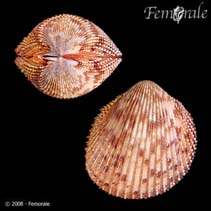Trachycardium muricatum (Linnaeus, 1758)
American yellow cockle| Native range | All suitable habitat | Point map | Year 2050 |

|
| This map was computer-generated and has not yet been reviewed. |
| Trachycardium muricatum AquaMaps Data sources: GBIF OBIS |
Classification / Names Common names | Synonyms | CoL | ITIS | WoRMS
Bivalvia | Cardiida | Cardiidae
Environment: milieu / climate zone / depth range / distribution range Ecology
Benthic; depth range 0 - 84 m (Ref. 83435). Tropical
Distribution Countries | FAO areas | Ecosystems | Occurrences | Introductions
Western Atlantic.
Length at first maturity / Size / Weight / Age
Maturity: Lm ? range ? - ? cm Max length : 7.0 cm DL male/unsexed; (Ref. 83435)
Short description Morphology
Shell with circular to oval outline, equivalve, higher than long. Sculpture of 30 to 40 radial ribs with sharp scales. Scales less prominent on central ribs. Hinge well developed. Colour: extremely light cream with irregular patches of brownish red or yellow; internally white, rarely yellowish (Ref. 344).
It is 5 cm in size (Ref. 344). Maximum depth from Ref. 104365. Buried in sand in moderately shallow subtidal conditions, sometimes in coral reef environments (Ref. 344). Inlet influenced (Ref. 104365).
Life cycle and mating behavior Maturity | Reproduction | Spawning | Eggs | Fecundity | Larvae
Members of the class Bivalvia are mostly gonochoric, some are protandric hermaphrodites. Life cycle: Embryos develop into free-swimming trocophore larvae, succeeded by the bivalve veliger, resembling a miniature clam.
Main reference
References | Coordinator | Collaborators
Leal, J.H. 2003. (Ref. 344)
IUCN Red List Status (Ref. 130435)
CITES status (Ref. 108899)
Not Evaluated
CMS (Ref. 116361)
Not Evaluated
Threat to humans
Human uses
Fisheries: commercial
FAO - Fisheries: landings | FishSource |
Tools
More information
Internet sources
BHL | BOLD Systems | CISTI | DiscoverLife | FAO(Fisheries: ; publication : search) | Fishipedia | GenBank (genome, nucleotide) | GloBI | Gomexsi | Google Books | Google Scholar | Google | PubMed | Tree of Life | Wikipedia (Go, Search) | Zoological Record
Estimates based on models
Preferred temperature
(Ref. 115969): 25.7 - 28, mean 27.2 (based on 234 cells).



